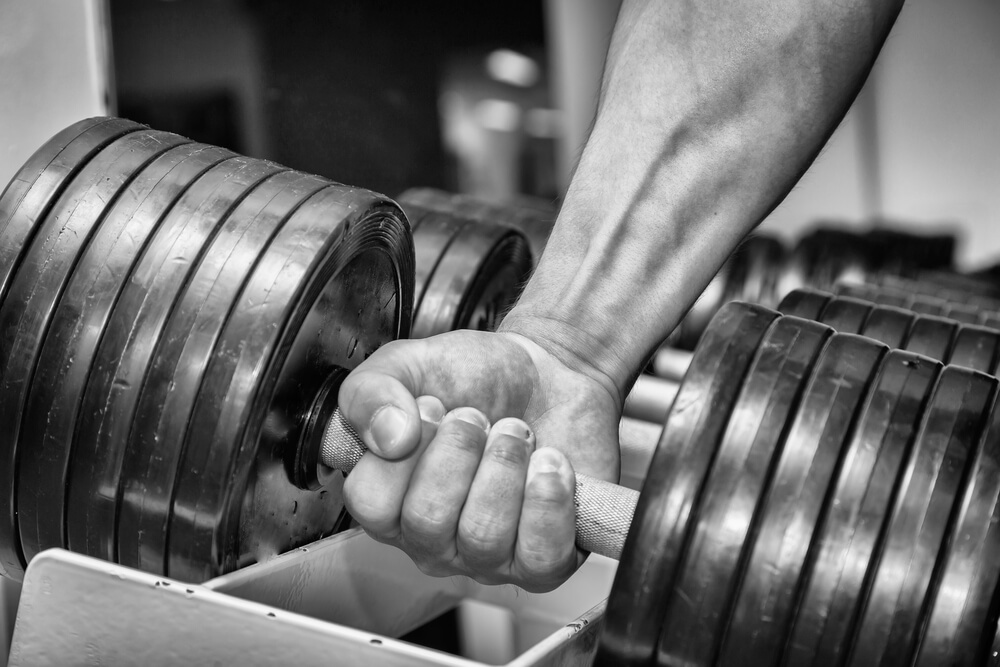
Strapped for time but still want to get in a weight lifting workout plan? Don’t worry. It can be done. We have the plan to get it all done in only 20 minutes.
You made the right choice to go to the gym and build muscle, but you only have 20 minutes. How do you strategically maximize pushing and pulling the iron to get a muscle building workout?
We have the answer.
We also salute you for making the right choice and not using the time excuse to skip a workout. As you’ll find out, 20 minutes, when used right, is plenty of time to build muscle, force a raging pump and leave with topped out endorphin levels.
We’ll give you new strategies for creating a quick and effective workout that will allow you to lift as much as possible on each and every exercise. Once the strategies and logic are laid out, you will get the perfect 20-minute iron workout and ways to progress it.
The Quick Weight Lifting Workout Plan (The Big Picture)
The big challenge with this workout is the time constraint. To fit in a workout that targets every muscle proportionally requires serious strategy. The best way to do this is by focusing on compound movements that engage multiple muscle groups at the same time.
In a normal bodybuilding split, each workout starts off with these big compound movements. These movements are effective because we can lift the most amount of weight on these exercises. The more we lift, the more we grow. Think of this workout as a sort of like an all-star team of exercises. We are going to put all the best exercises from every workout into one superstar battle with the iron, but of course with some crucial tweaks.

Focus On Strength And Growth
Sticking to a certain rep range for every exercise can yield results for a time. But, just like changing up programs, sets and reps have to vary. This workout takes advantage of the benefits of multiple rep ranges. It will focus on strength by using the six to eight rep range resulting in moving really heavy weight at fast tempos.
The sheer weight will tear down muscle fibers in a way the body can only respond to by building back the muscle stronger and bigger. It’s vital that the reps do not fall below the six to eight rep range, though.
Less is not more here.
The heavier the weight gets, the longer the body takes to recover. With only 20 minutes, no time can be wasted. As we will discuss later, maximizing the ratio of work to rest is very important.
The beloved higher rep range of eight to 12 will also be used. The higher reps will build a massive pump leading to transient growth. The pump is not only proven to stimulate growth, but it also makes us feel awesome and is a signal that the muscle is responding to the workout. The variety in rep ranges will also allow your body to recover different energy systems furthering the workout efficiency.
Work Now Rest Later
This workout is designed for the go-getter. There’s no time for texting or making small talk. Leave that approach for others. It’s all about making the most of your time. That’s why it’s designed so that rest is only taken as needed. We use a variety of rep ranges so that we get all the benefits of variance, but also so that rest is not needed.
For example, as the first strength exercise is completed, the next exercise uses a different muscle group so less recovery is needed. Once the original muscle group is called on again the actual muscles will have rested but not the body as a whole.
This maximizes time under tension and minimizes rest. The end goal of this workout should always be to have at the very least a 1:1 ratio of work to rest, and hopefully better. The more time that is spent working, the more muscle that can be targeted.
Use Smart Circuits
To truly get all the benefits, every detail has to be set perfectly in place. As the varying reps allow for more work to be completed, alternating movements and muscle groups does the same. The workout follows the pattern of cycling through different main movements.
As you will see, they focus on lower body, upper body push, upper body pull or core. As these exercises are cycled through it means muscle groups will rest for over a minute before they’re called upon, which is the standard for most workouts. Even though it might seem obvious not to work the same muscle group twice in a row given that the weight and intensity will decrease, there is more to it than that.

Alternate Spinal Loading And Decompression
When creating a circuit, the body has to be viewed as a whole. Consider barbell lunges and bent over rows. While one is lower body dominant and the other is an upper body pull movement, they have a common link.
They both load the core and importantly the spine.
If these exercises are performed one after the other, there will be a huge drop off for the second exercise.
Rather than the targeted muscles reaching failure, it will be the low back and core. Add a few more exercises to the mix haphazardly and it is a recipe for injury, unnecessary rest and reduced weight.
How can this be combated?
By designing the workout to alternate spinal compression and decompression. Each exercise that heavily loads the spine and core like squats, step-ups, and inverted rows
By designing the workout to alternate spinal compression and decompression. Each exercise that heavily loads the spine and core like squats, step-ups and rows is always followed by an exercise that requires much less spinal loading such as chest presses and pull-ups. That is what’s called a smart circuit.
The core will be immensely challenged even alternating spinal loading and decompression, but the targeted muscles will not be negatively impacted by it. This is an important consideration for any workout.
Before super setting or circuiting exercises together, consider what’s more important: Maxing out the core or maxing out certain muscles?
You Need A Good Workout Flow
Having a good flow isn’t just important for your hair, it’s also needed for this workout. The workout uses a mix of equipment, which is good as it builds in rest but will also require discipline. Performing this workout during a less crowded time is advised, but if the gym is crowded don’t stress.
If the decision has to be made between waiting to do a precise movement or doing something similar to avoid waiting, you know what to do.
Get on and get going.
Don’t stress and don’t rest. There’s only 20 minutes and that does not include waiting on people who sit on equipment getting their finger workouts texting away. Always keep a close eye on the clock to ensure the workout stays on pace.
You Should Always Strive To Improve
This workout starts off by doing two sets of each movement. This will undoubtedly be challenging as is, but the end goal is to do three full rounds in less than 20 minutes. To do this, the only rest will come from moving to the next exercise.
In addition to striving for three sets on each exercise, there are also two levels of this workout to choose from. They have the same foundation in terms of movements, but the Warrior level uses movement manipulation. The standard workout uses the typical bilateral and more stable movements even with some machines to truly rest stabilizing muscles.
The Warrior workout tosses all those crutches aside and uses methods such as alternating arms, unilateral loading, momentum lifting and challenging starting positions. The Warrior level challenges muscles to work from new angles and tempos that ultimately result in greater growth. Although less weight might be used, the nontraditional switch up pushes the muscles to new boundaries.
Be warned: The two workouts may be the same at heart, but the difficulty is in no way similar. If you are feeling unsure of what level to choose, try the standard workout and build up to the Warrior level by slowly swapping out individual exercises.

Weight Lifting Workout Plan: Standard Level
Before getting started make sure to properly warm-up, hydrate and eat for best results. Complete at least two rounds within 20 minutes, resting only as needed.
- Front Squat 2×6
- Dumbbell Chest Press 2×8
- Dumbbell Row 2×10
- Hammer Strength Overhead Press 2×10
- Alternating Lunge 2×12
- Lat Pulldown 2×12
- Plank 2×30 seconds

The Warrior Workout
As these movements are more complex and less traditional, you need to make sure they are done correctly and safely. Don’t worry. We have some tips to help.
Bottom Up Squat
Adjust the squat rack so that the safety bar lines up with the lowest point of your squat and place the bar there. Position yourself under the loaded bar at the bottom and squat the weight up. After each rep, allow the bar to completely rest on the safety bar before lifting it up again. This squat has to be done lighter. But, rest assured, any heavier and stairs will become a living hell.
Alternating Dumbbell Chest Press
Set up like a normal chest press for this exercise. Rather than lowering both dumbbells at the same time, keep one up while the other is lowered and pressed back up. Alternate arms keeping one dumbbell up.
Kroc Row
Pick a slightly heavier weight than you would for a normal dumbbell row. Rather than trying to keep the torso and shoulder still, use momentum by rocking the body down and up for consecutive explosive reps. This causes a greater stretch in your muscles and an overload from the extra weight.
Seated Bradford Press
Use a standard barbell military press rack. Each rep alternates between pressing the barbell overhead behind the neck and in front of the face. Less weight is needed, but your deltoids will be screaming by the end.
Barbell Step Up
Using a box slightly above knee height, place one foot flat on the box with the barbell loaded across the back. Keeping your body aligned, step up so your ground leg reaches the box. Without placing your foot on the box, lower back down and repeat. To eliminate cheating, keep your unloaded leg’s knee extended and foot flexed.
By only tapping the heel and keeping a straight leg, your bottom leg can’t assist in the movement. Perform all reps on one side and then switch.
Weighted Pull-Up
Use a weight belt to attach a plate around your waist. Perform a pull-up as normal ensuring a full range of motion is reached on every single rep.
Single Arm Farmers Walk
In one hand hold a dumbbell similar in weight to what was used on the chest press. Keeping your shoulders and hips level, walk 30 meters, switch sides and return back 30 meters.
Complete at least two rounds within 20 minutes, resting only as needed.
- Bottom Up Squat 2×6
- Alternating Dumbbell Chest Press 2×8
- Kroc Row 2×10
- Seated Bradford Press 2×12
- Barbell Step Up 2×12
- Weighted Pull-up 2×12
- Single Arm Farmers Walk 2×30 meters each
Conclusion
These workouts ensure that every second of the 20 minutes is used to potential. Not one second of it will be easy, but every second will be worth it. Even as the lactic acid builds, your lungs burn and your heart pounds, remember it’s only 20 minutes and the intensity has to be pushed.
The strategic layout of the movements, rep ranges and diversity of movement performance all culminate to give you a workout that yields quick results. Continue to strive for improvement in the weights and the total number of rounds completed then welcome in the muscle building gains that will ensue. There are no more excuses for not having enough time to exercise and hit your weight lifting workout plan. Use this 20-minute weight lifting workout plan and get after it!
By Raphael Konforti CPT, MS
Latest posts by Raphael Konforti (see all)
- The Best 4 Day Workout Split For Greater Gains - Feb 6, 2017
- The Best Lower Chest Workout For A Better Body - Aug 15, 2016
- How To Get Rid Of Shin Splints - Jul 7, 2016










[…] http://gymjunkiesmain.wpengine.com/weight-lifting-workout-plan-twenty-minute/ […]